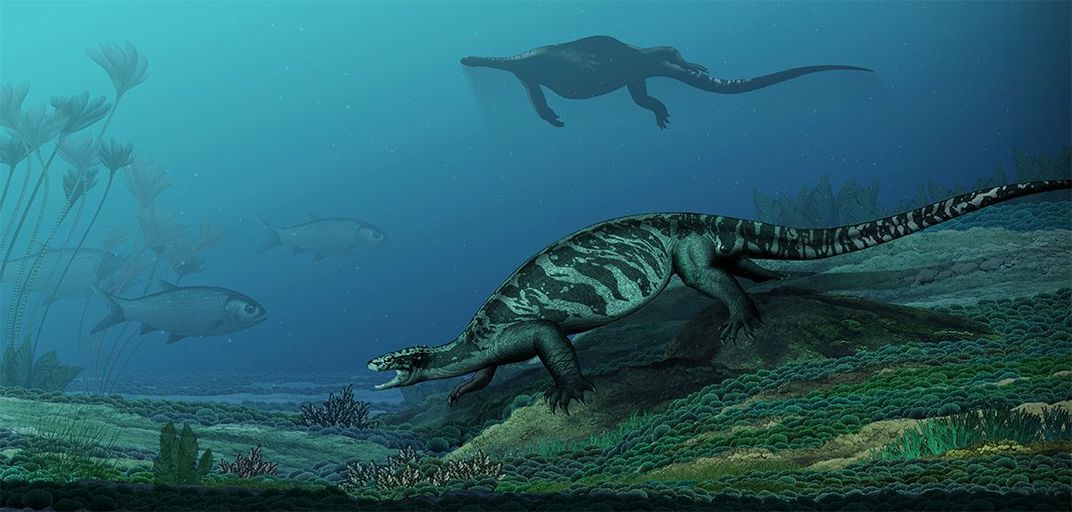Newly Discovered Turtle Ancestors Chomped With Beaks But Bore No Shells
A 228-million-year-old fossil fills gaps in the tale of turtle evolution—and raises a few questions
/https://tf-cmsv2-smithsonianmag-media.s3.amazonaws.com/filer/90/37/90376a40-c218-4238-b31e-451c24dc7963/d41586-018-06012-0_16060616.jpg)
If a turtle grows a body without a shell and no one is around to eat it, is it still a turtle? A newly-discovered 228-million-year-old fossil says yes. Yesterday, in the journal Nature, a group of scientists reported the discovery of an ancient turtle in Southwestern China, sporting some pretty not-so-turtley features: Not only was this foregone reptile over six feet long, but it also swam shallow waters completely barebacked.
Turtles are funny creatures. With their endearingly sluggish pace and somber mugs, they’re the toothless grandparents of the reptile family. Two of their most distinctive features are their characteristic shell and pointed, bird-like snouts. But the evolution of the shell puzzled scientists for decades.
“[Turtles] have a straightjacket of a shell,” said study co-author Nicholas Fraser, a paleontologist the National Museum of Scotland in Edinburgh, in an interview with BBC. Essentially, Fraser explains, turtles’ shoulders are enclosed within their rib cages—not exactly the most flexible arrangement. It’s part of what explains turtles’ less-than-impressive locomotion. One would think the turtle must have a pretty dire need for this strange setup to make it worth the price of limited mobility.
If your engine tops out at just a few miles an hour, some hardy body armor might come in handy—and for a long time, this seemed the most logical explanation for the evolution of the turtle shell. However, the earliest semblance of a turtle shell—essentially an outgrowth of the animal’s rib cage—was poorly suited for defense. It covered only the turtle’s belly, leaving its head, neck and shoulders vulnerable to attack.
After the discovery of these half-shelled turtles, some scientists began to wonder if the original shell evolved not as a fortress, but as a stabilizer. The debate still isn’t settled, but it seems turtle ancestors spent much of their time burrowing through soil and sand. Over time, evolution may have shaped them into living spades: stout, flat and solid. Other perks like protection came much later.
But long before turtles nestled themselves into a even this one-sided breastplate, they strutted around in the buff. This new specimen, dubbed Eorhynchochelys sinensis (deep breath—ready? That’s “ay-oh-rink-oh-keel-is,” which translates roughly into “the first beaked turtle,” “syn-en-sys,” a nod to the excavation in China), was basically a gargantuan Frisbee with a long tail—already wide and waddly, but unshackled by a shell. This seems to be in keeping with previous theories of turtle evolution: First, a shell-less ancestor donned only front-facing armor, creating an open-faced reptilian sandwich. The loop eventually closed around 200 million years ago, forming the full rib-based shell and locking the modern turtle into place.

Additionally, E. sinensis fills a longstanding gap that has separated turtles from other reptiles. Most other reptiles share what appears to be a crucial anatomical trait: two pairs of holes in their skulls behind their eyes, where large, strong jaw muscles are anchored. Modern turtles lack these holes entirely, but the oldest turtle ancestor, dating back roughly 240 million years, still had the openings in its skull. With this work, scientists now know that 10 million years later, at least some turtles closed the gap halfway: E. sinensis plugged up one opening on each side, retaining only a single pair of holes behind its eyes.
But evolution is not a direct process, and scientists still have an incomplete picture of the turtle’s trajectory, according to Rainer Schoch, an amphibian and reptile paleontologist at the Stuttgart State Museum of Natural History in Germany, as Jeremy Rehm reports for Nature News. E. sinensis is the earliest known turtle that bit with a beak, while others before and after it nibbled their way through life with full sets of teeth. This means the turtle beak may have blipped in and out of existence along different lineages, and scientists have yet to fully disentangle the specifics. Clearly, turtle evolution wasn’t an entirely straight line, and future finds may yet change current interpretations of how even the shell was set into place.
Schoch, however, remains hopeful, that as more turtle ancestors are excavated from the fossil record, the puzzle pieces will fall into place, Rehm reports.
Ultimately, what we see in modern turtles is a bit of a convergence: The most useful traits, including the beak and shell, eventually came together, yielding the pleasant, plodding turtle friends we know and love today. As the saying goes, it’s turtles all the way down—so with the weight of the world on their backs, those shells probably come in handy.
/https://tf-cmsv2-smithsonianmag-media.s3.amazonaws.com/accounts/headshot/10172852_10152012979290896_320129237_n.jpg)
/https://tf-cmsv2-smithsonianmag-media.s3.amazonaws.com/accounts/headshot/10172852_10152012979290896_320129237_n.jpg)